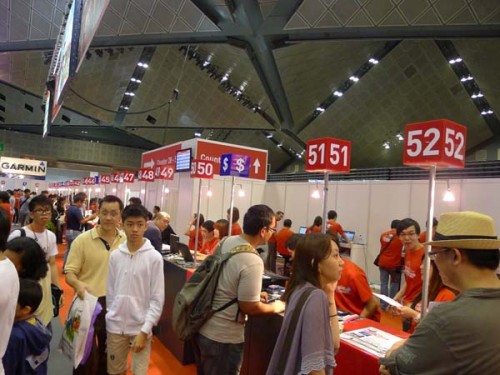When M1 put up those banners for S$39-a-month fibre broadband services last week at the PC Show, its rivals must have cursed as much as consumers cheered for a “market spoiling” deal that once again proved how cheap high-speed Internet services have become in Singapore.
A laggard in broadband services and their takeup just a few years ago, Singapore is now one of the world’s leading fibre broadband capitals for not just the variety and low cost of offerings but also the way the market has been regulated.
The numbers don’t lie. At each quarterly computer bazaar, more than 3,000 users sign up for these fibre broadband services that promise faster speeds at cheaper prices.
The contractor rolling out the network, Opennet, cannot cope with the demand. As some 95 per cent of the island gets hooked up next month, the takeup for such services is only going to accelerate.
Yet, there is much to improve. If the first wave in the past two years is about takeup, then the next one has to be about improving the experience. Old ways of doing things need to go out of the window to give users the full improvements of fibre broadband.
Here are a few changes that will help.
1. Provide tiered services based on experience, not just top speed
Forget about that Speedtest result. Often this is the maximum speed you can connect to a few selected servers, which may not even host the games, movies or Internet sites that you access all the time.
Similarly, telecom operators should concentrate not just on selling the top speed offered by a service but also the experience it provides. Granted, top speed is the easiest metric to understand and many users will only surf the Web or update Facebook statuses with their Internet links, so there is little to “differentiate” one service from another, as long as it’s reliable.
But for heavy users or more discerning ones, tiered services such as those that promise lower latency to, say, game servers will surely be more attractive. It’s a sign of the maturing broadband market that MyRepublic, ViewQwest and M1 all offer “premium” offerings that promise lag-free connections to the world’s online game servers.
ViewQwest is even bolder as to claim no more than 200-millisecond connections to servers such as Blizzard’s popular Diablio III. That claim, of course, is subject to Blizzard’s server conditions.
So what’s the difference between a “regular” and “premium” service? Essentially, the premium one takes the “best routes” to the servers that host content that you often access. These are usually the shortest, fastest and least congested over the complex network of the Internet. It’s like being driven by a savvy taxi driver who takes the fastest route from your home to the office, with the knowledge of where the jams usually are.
Why don’t telcos offer this to everyone? It’s simple: first, it’s cost and second, they cannot cater to everyone. They do try to take the best routes to major United States hubs in the East Coast and West Coast, where a lot of the world’s content is hosted. But increasingly, a lot of Singapore users are also heading to websites hosted in China and India, so there’s extra cost involved if telcos were to buy other “optimised” routes to these destinations.
At the end of the day, there is no sure-win formula to find all the best routes to the millions of sites that users here go to. To make most users happy, telcos will try their best to connect to the most popular ones, say, YouTube.
However, it will be good for telcos to start targeting specific segments of users, say, gamers or even traders, who require low latency and higher quality connections to certain servers. Business-grade connections offer this type of differentiation. Hopefully, consumers (who are willing to pay a bit more) can get more differentiated services that cater to their usage.
2. Don’t hold back users
Despite the enormous amount of bandwidth that is capable over this new network, one industry secret that many consumers are not aware of is that many telcos still hold people back from fully utilising the resources.
Opennet lays the cables and at least until recently, an operating company (OpCo) called Nucleus Connect used to be the only one to offer wholesale “bandwidth” to any Internet service provider (ISP) that wants to sell fibre broadband services.
It offers four classes of services, from Class A to Class D, with varying quality even though they are all sold as 100Mbps offerings. At the top, for Class A, you get what is known as a “real time” connection, where there is little lag and you typically don’t get squeezed out during peak hours.
Class B is called Near Real Time, Class C is termed Mission Critical and the worst, Class D, is Best Effort. So, even though you and your friend both have a 100Mbps connection, chances are your experience may be different during peak hours because one of you may have the “right of way” in a jam, resulting in a faster connection.
Worse, all four classes of this 100Mbps connection start with only a committed minimum bandwidth of 25Mbps. Yes, 25Mbps. This figure, called a committed information rate or CIR, from Nucleus Connect was all that was available to telcos, who then have to buy incrementals of 5Mbps upgrades if they wanted to offer a user a service that resembled more like the 100Mbps top speed on paper.
It’s not that telcos are lying when they say they are offering 100Mbps. What they are not telling you is that their supplier has not guaranteed them anything above 25Mbps – unless they paid extra – and the full 100Mbps is available only in “bursts”. In a grab for market share that keeps pushing prices down, guess which class of service and what quality they will offer?
Surely, that has to change. In the old days, telcos really needed to portion out the bandwidth, lest congestion set in. But not now.
With fibre broadband, there are no such issues. The bandwidth that is supported by the cable and the network equipment in place today far exceeds the 100Mbps that is typically offered to homes and offices. There is just no good reason for telcos to hold back by slicing and dicing by 5Mbps permutations.
The good news is the regulator has allowed competitors to come in to rival Nucleus Connect in recent months. Previously, all telcos had to buy wholesale connectivity from it and all the services were undifferentiated and frankly, held back by what Nucleus Connect offered.
Today, SingTel runs its own switches and other “active network equipment”, as do M1 and ViewQwest. StarHub owns Nucleus Connect, so it understandably uses its own wholesale provider.
The result of this change is differentiated services. Now, with control of their own equipment, even small players like ViewQwest can sell a gaming service that can offer better quality than, say, a Class D service wholesaled from Nucleus Connect.
The challenge going forward is for all telcos to improve the experience and push for all 100Mbps services to be offered with what was known as Class A quality and with 100Mbps fully turned on, all the time.
You wouldn’t deliberately make the 100Mbps port on your router run at 25Mbps and surely you wouldn’t want your telco to do the same for a 100Mbps service!
3. Have open peering within Singapore
Yet another industry secret is the lack of full peering among the telcos here. Usually a commercial arrangement between telcos, peering means that they exchange traffic freely. The result: very fast connectivity between their users.
The problem, though, is that such peering arrangements exist among Singapore’s earliest Internet service providers, namely SingTel, StarHub (through Cyberway, which it bought in 1999) and Pacific Internet, and not with newer fibre broadband operators such as M1 and ViewQwest.
The result: less than optimal connections even when you are sharing files with friends in Singapore. If you are on SingTel or StarHub, try downloading a file from a friend who’s on M1 or ViewQwest. Chances are, you won’t get near the 50Mbps upload speeds he can offer with his connection.
This is because challengers like M1 and ViewQwest are not peering with the older players. To get their users that full 50Mbps upload to users on SingTel and StarHub, the new players have to pay SingTel and StarHub for the hookup. And their asking price? As much as three times what it costs to connect to an overseas telco.
So, what do the new players do? They sometimes route their traffic overseas before “coming back” to Singapore. You guessed it, the result is a slower connection and higher latency. A poor route.
Sometimes, smart engineers try a back door, say, by buying a Singapore link to or by peering locally with Hong Kong’s PCCW, which has an international peering arrangement with SingTel or StarHub. This lets them connect “locally” to the rest of Singapore’s subscribers at a lower cost and through a better route than going overseas and back.
But even so, that maximum 50Mbps upload that your line is capable of is probably slowed down to a fraction of that, because of such inefficient routes.
Users have to ask why SingTel and StarHub are allowed to do this. Sure, they will say that they have more traffic and thus would not benefit from freely exchanging traffic with smaller players. But how does this help Singapore’s broadband experience? Surely, asking users to send their data overseas and back is making the country’s speedy fibre network a white elephant.
Though there are various Internet exchanges where all local telcos are hooked up, they are not exchanging traffic freely because of commercial terms dictated by the bigger players. As a result, the broadband experience in Singapore is uneven and often for the poorer because of the roundabout routes that users have to take to reach their destinations.
This is where the infocomm regulator has to step in. If it wants to fully tap on Singapore’s new network, it has to have all local telcos big and small exchange local traffic freely.
By removing the “tax” that big players can impose on new entrants, it will better the experience for users sharing files within the country and also save smaller telcos a bundle in connecting to overseas partners to get to local destinations.
You can already hear SingTel and StarHub scream that this is unfair, but surely, it is within the Infocomm Development Authority’s (IDA’s) job scope to ensure a level playing field and to offer a better deal for users. Such a move will also be in keeping with the spirit of opening up the market.
4. Let users run servers
For the longest time, telcos have feared that users and small businesses could one day run their Web or FTP servers from home with a cheap broadband line and saturate their network with traffic.
That mindset, unfortunately, has taken hold in many executives in the industry. And that’s the reason why they block port 80 – the port used by Web browsers to access a server’s webpages – on all home connections and only offer dynamic IP addresses which change over time so you cannot easily map a domain name, say, Techgoondu.com, to a server at home.
But that’s outdated thinking. While previous broadband technologies offered slow uploads – usually a small fraction of the download speeds – fibre broadband comes with enormous upload bandwidth.
A 100Mbps fibre service typically comes with 50Mbps uploads and M1’s GamePro service even has 100Mbps downloads and uploads. With current network equipment, there is little chance that a few chaps – or indeed hundreds of people – running simple FTP servers will clog up the network.
Actually, the opposite is true. If telcos hold back the bandwidth and keep a user on the network longer as he downloads or uploads a file, wouldn’t that user hold up the network longer? Would it not be better if he’s able to get his file faster and thus go off the network so the next guy can come onboard?
These are things that some telcos, in their years of trying to control and shape their networks, have yet to see. For once, the network is so capable it needs fewer controls and limits for a better experience. In their ads, telcos have been telling people that a faster service lets everyone at home surf without worry of being jammed up – they should believe their networks can deliver the same too.
It’s heartening again to see the likes of ViewQwest offering static IP addresses to homes, a first here, recently. Those who want to run FTP servers will do so anyway by signing up for services that link their changing IP addresses to home servers. So, why not just make it simpler by offering a static IP? Most telcos do assign one public IP address to every subscriber so why not make it static?
Going forward
Singapore already has some of the best broadband deals around and the next step for the country has to be about the improved experience that the fibre network can offer.
Many people will still be simply surfing the Web on their 100Mbps services because the price is low, compared to their previous services. But that benefit comes from a departure from years of little real market competition before the next-gen broadband network was built. The next step has to be about really using the network for new applications.
Think of the elderly “seeing” a doctor virtually at home, instead of taking an expensive taxi ride to the hospital. Home business owners can have video conferences instead of driving down to town for a meeting. More Internet content will flow into Singapore because it’s a speedy, well-connected hub for such services.
But first, the way the networks are run has to change, as more users get onboard. Mindsets have to change.
Ultimately, it is still the consumer voting with his dollar that telcos fear the most. So, change has to come from ground up sometimes.
And what better way to tell telcos to improve than by joining a survey, like Sam Knows, to inform them of your real world experience? Only with competition, especially when they see their numbers next to rivals’, will they buck up.
Share your fibre broadband experience in the comments and help improve things!








In Iceland most homes have 100Mbps fiber connections.
In Iceland most homes have 100Mbps fiber connections.
In Part 4. Let users run servers, last paragraph,It is MyRepublic that offering the static IP and hosting policy, not ViewQuest.
Local peering is available with SGIX (http://www.sgix.sg)
It’s beginning to pick up momentum, Amazon, Voxel etc onboard.
The peering situation is actually quite interesting. Singapore has become a local hub for indian, indonesian, malaysian telcos to peer. Newcomers to the NSP/ISP singapore scene also peer easily with a very straightforward policy, but most of the eye balls are still with starhub/singtel and backwards peering policies. But that’s because a fat part of their network is paid and by consumers and by content providers. The only real hope, a shift in eyeballs – singtel policies on peering in singapore seem written in stone.
It’s also possible, don’t forget, that the prohibition on residential users running servers is imposed or encouraged by the authorities. Self-censorship works best on businesses (like SPH) because commercial interests are paramount. Individual-owned servers may not respond as well to that, which would force Singov to deal with the fallout from ordering telcos to pull the plug.